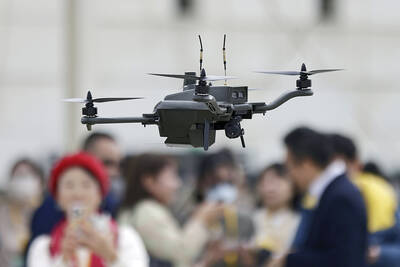The Chinese People’s Liberation Army (PLA) intends to achieve the capability to impose a joint blockade of Taiwan by 2035, the Ministry of National Defense (MND) said yesterday in its latest report on China’s military.
The ministry submitted the report to the Legislative Yuan alongside the proposed defense budget and the military’s five-year force structure plan.
The PLA aims to achieve conventional and nuclear second-strike capabilities that would allow it to enforce a blockade of Taiwan and prevent outside intervention, the report said.

Photo: Reuters
At the same time, Beijing is expected to continue efforts to turn the Taiwan Strait into its de facto territorial waters — including frequent incursions across the median line, as well as intrusions into Taiwan’s 24 nautical mile (44.4km) contiguous zone, it said.
China’s armed forces are also stepping up efforts to have the capabilities to conduct patrols and drills east of Taiwan, while developing the means to project power as far as the second island chain, it added.
Although “active defense” remains at the core of China’s national defense policy, the PLA is clearly shifting toward a more proactive geostrategic posture, as demonstrated by its activities near the second island chain and in the South Pacific, the report said.
The PLA Ground Force is prioritizing the development of uncrewed platforms for urban combat support, as well as enhancing joint warfare capabilities and conducting large-scale amphibious exercises across multiple theater commands, it said.
The PLA Navy (PLAN) is pursuing modernization aimed at establishing defense in depth to keep foreign forces out of the waters between the first and second island chains, it added.
The PLA Air Force (PLAAF) seeks to transform into a strategic force able to conduct precision strikes, air mobility and logistical operations as far as the second island chain, the ministry report said.
Meanwhile, the PLA Rocket Force (PLARF) is expanding its nuclear arsenal to achieve a credible second-strike capability, it said, referring to the ability to survive an initial nuclear attack and retaliate with atomic weapons.
AIRCRAFT CARRIERS
On China’s arms acquisitions, the MND said the aircraft carrier Fujian has completed its eighth sea trial, certifying its propulsion, electronic, electronic warfare and combat systems.
The PLAN is also testing and inducting a range of carrier-based aircraft, including the Shenyang J-15T — a variant of the Shenyang J-35 — and a new airborne early warning and control platform, it said.
These aircraft are expected to form the air wings of the Liaoning and Shandong carriers, providing the core capability for an expeditionary, operation-ready blue-water navy, it added.
The PLAAF is hastening efforts to develop its sixth-generation fighters to achieve “all-dimensional response” capabilities, while the PLARF is expediting the deployment of new anti-ship ballistic missiles and hypersonic weapons, it said.
CYBERWARFAE
Beijing sees cyberwarfare as an integral component of modern military operations and its modus operandi is to infiltrate adversary networks in peacetime and lie dormant until hostilities erupt — at which point pre-positioned cyberweapons could be activated to paralyze enemy systems, it added.
In terms of firepower, the PLA’s operational focus is on massed strikes employing multiple types of munitions to overwhelm defenses, followed by successive attacks to ensure the destruction of enemy assets and forces, the MND said.
Regarding Beijing’s broader foreign policy, its Belt and Road Initiative is being leveraged to deepen military and economic ties with regional states as a counterweight to the US-led Indo-Pacific strategy, further isolating Taiwan from the international community, the MND added.
Beijing is expected to use the initiative to reinforce its narrative that Taiwan is an inseparable part of its sovereign territory — a narrative the regime defines as a core national interest, it said.
REORGANIZATION
The ministry also outlined Taiwan’s force structure plan for the next five years, emphasizing resilience through stronger logistics and battlefield medicine.
A backup fiber-optic network is to be laid across Taiwan proper to ensure critical military communications can be maintained under attack and improve the survivability of command headquarters, the MND said.
The army would prioritize enhancing command-and-control systems to enable commanders to form a clear operational picture, integrating drones into combat operations and strengthening rapid-deployment capabilities, it said.
Planned acquisitions include M1A2T main battle tanks, F-16C/D Block 70/72 jets, F-16V upgrade packages, High Mobility Artillery Rocket Systems and tactical data link systems, it added.
The armed forces have also established or reorganized several units to adapt to the reinstated one-year compulsory military service, new operational concepts and emerging weapon systems, the ministry said.
The air force’s 7th Tactical Fighter Wing has stood up the 45th Squadron; the 66th Marine Brigade converted tank and artillery battalions into a drone battalion and a fires battalion; the navy’s anti-submarine aviation group was reorganized into a brigade; and the Army Command Headquarters created a new air defense and uncrewed systems section, it said.

The combined effect of the monsoon, the outer rim of Typhoon Fengshen and a low-pressure system is expected to bring significant rainfall this week to various parts of the nation, the Central Weather Administration (CWA) said. The heaviest rain is expected to occur today and tomorrow, with torrential rain expected in Keelung’s north coast, Yilan and the mountainous regions of Taipei and New Taipei City, the CWA said. Rivers could rise rapidly, and residents should stay away from riverbanks and avoid going to the mountains or engaging in water activities, it said. Scattered showers are expected today in central and

COOPERATION: Taiwan is aligning closely with US strategic objectives on various matters, including China’s rare earths restrictions, the Ministry of Foreign Affairs said Taiwan could deal with China’s tightened export controls on rare earth metals by turning to “urban mining,” a researcher said yesterday. Rare earth metals, which are used in semiconductors and other electronic components, could be recovered from industrial or electronic waste to reduce reliance on imports, National Cheng Kung University Department of Resources Engineering professor Lee Cheng-han (李政翰) said. Despite their name, rare earth elements are not actually rare — their abundance in the Earth’s crust is relatively high, but they are dispersed, making extraction and refining energy-intensive and environmentally damaging, he said, adding that many countries have opted to

FORCED LABOR: A US court listed three Taiwanese and nine firms based in Taiwan in its indictment, with eight of the companies registered at the same address Nine companies registered in Taiwan, as well as three Taiwanese, on Tuesday were named by the US Department of the Treasury’s Office of Foreign Assets Control (OFAC) as Specially Designated Nationals (SDNs) as a result of a US federal court indictment. The indictment unsealed at the federal court in Brooklyn, New York, said that Chen Zhi (陳志), a dual Cambodian-British national, is being indicted for fraud conspiracy, money laundering and overseeing Prince Holding Group’s forced-labor scam camps in Cambodia. At its peak, the company allegedly made US$30 million per day, court documents showed. The US government has seized Chen’s noncustodial wallet, which contains

SUPPLY CHAIN: Taiwan’s advantages in the drone industry include rapid production capacity that is independent of Chinese-made parts, the economic ministry said The Executive Yuan yesterday approved plans to invest NT$44.2 billion (US$1.44 billion) into domestic production of uncrewed aerial vehicles over the next six years, bringing Taiwan’s output value to more than NT$40 billion by 2030 and making the nation Asia’s democratic hub for the drone supply chain. The proposed budget has NT$33.8 billion in new allocations and NT$10.43 billion in existing funds, the Ministry of Economic Affairs said. Under the new development program, the public sector would purchase nearly 100,000 drones, of which 50,898 would be for civil and government use, while 48,750 would be for national defense, it said. The Ministry of